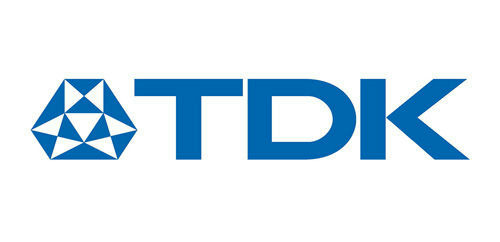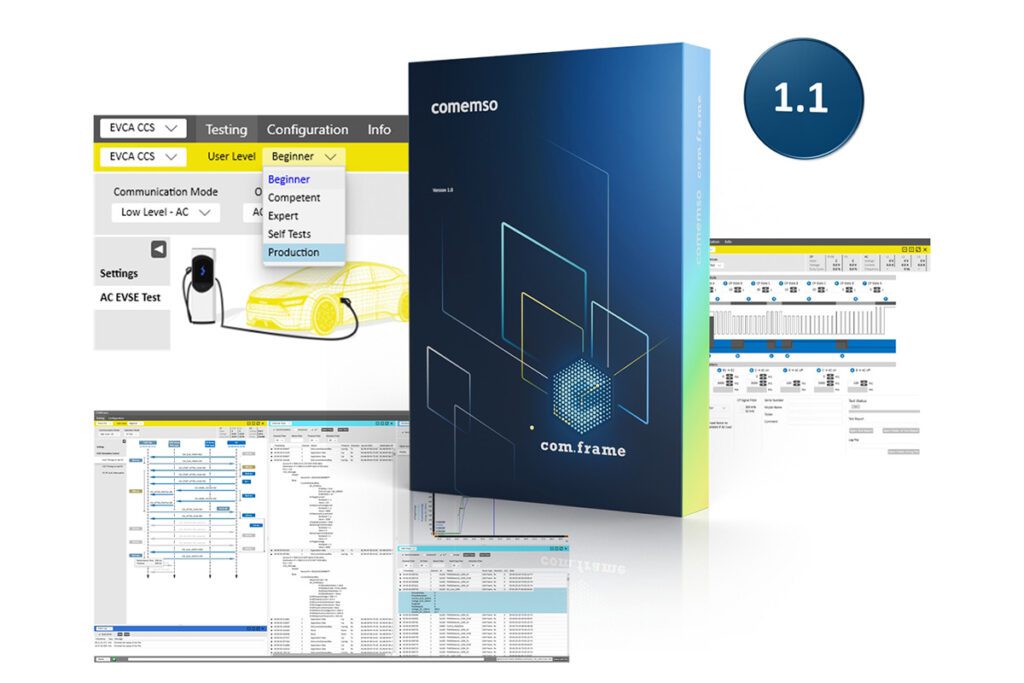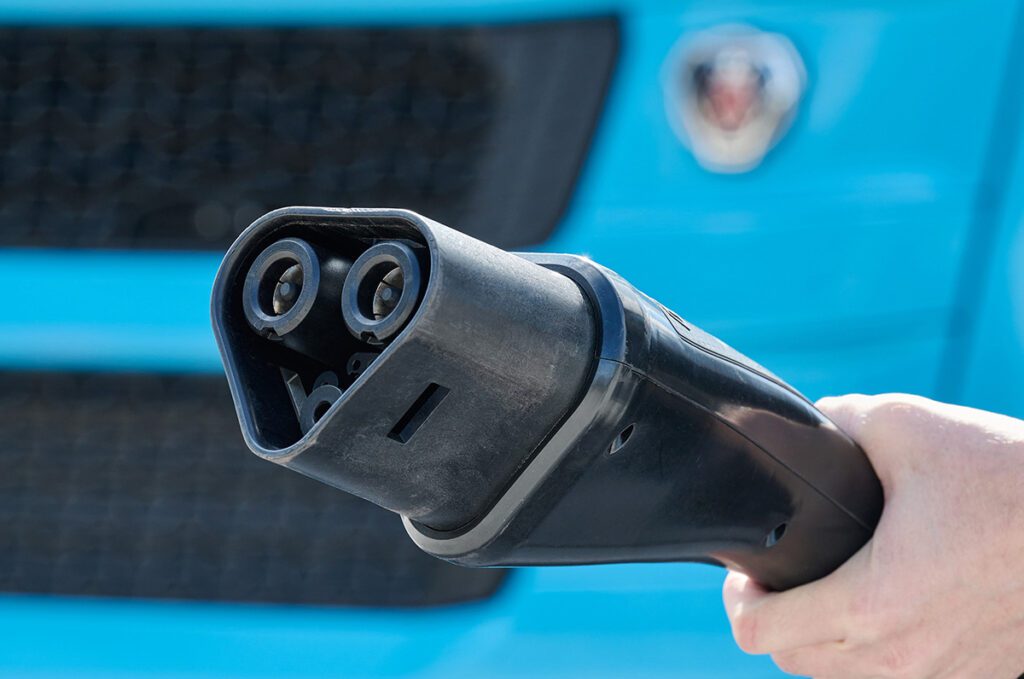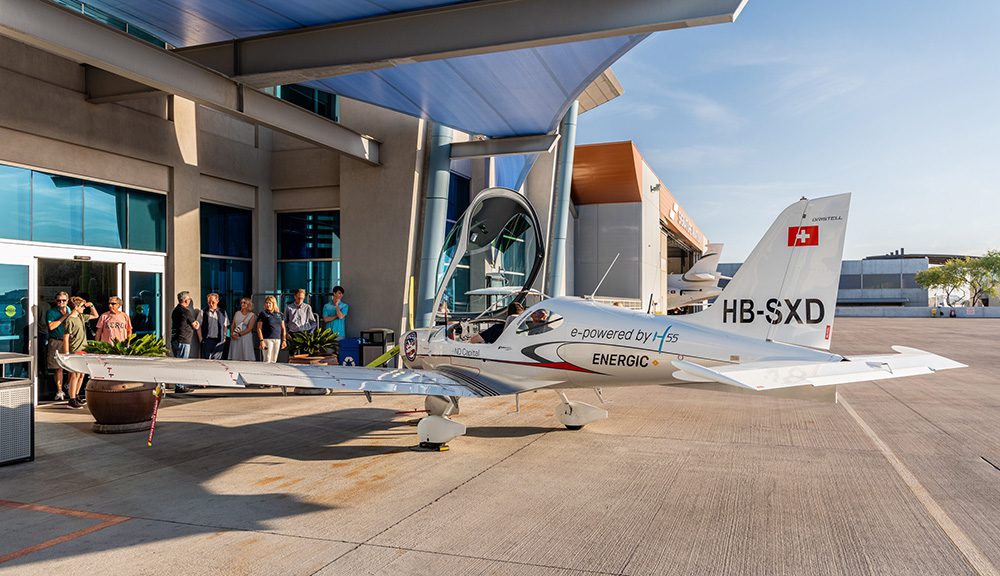In the popular imagination, aviation represents the last frontier for electrification. Considering the weight and limited range of batteries, an electric airplane might seem practically impossible. However, while electric long-haul airliners probably lie pretty far in the future, the fact is that, in some applications, the technical obstacles to electrified aircraft are not as formidable as one might think. NASA has been researching electric aircraft for several years, industry giants Airbus and Boeing are exploring the field, and several startups see opportunities in electric aviation. Charged recently sat down with executives from two young companies that are taking two different approaches to electrifying the skies.
EViation Aircraft
Omer Bar-Yohay is the founder and CEO of Israeli startup EViation Aircraft. He started the company in 2015, together with two other investment partners, after spending several years in the EV industry, including a stint with the ill-fated Better Place. “I really wanted to do this, and after a while I managed to convince enough engineers and enough investors to get this started,” he told Charged. “Being a physicist, you think [in terms of] what’s possible, and it seemed very possible. After starting, we found that, not only is it possible, but it’s probably less of a technology challenge than you think. I was looking at this for a very long time and I thought that a lot of the things that made sense in a car, but were difficult to obtain when you’re doing it electric, actually are easier with a plane. It doesn’t sound intuitive, but trust me, once you start looking at the numbers, it is.”

“It’s very hard to convince people, because they say, ‘Wait a minute. The electric car is having such a hard time getting out there in big numbers, so how are you going to do a plane?’ But a plane is almost by definition something that you share as a means of transport. One of the things that don’t work so well with electric cars is the cost, because of batteries – it’s very hard to compete with 100-year-old technology, so everything new you’re building is going to be expensive. But if you share [a vehicle] you don’t really care that it’s a little more expensive.”

As is the case in most commercial EV scenarios, over time the lower operating expenses more than compensate for the higher upfront cost. “Making the plane electric makes the direct operating cost of the aircraft lower, and this is because of the energy cost and the potential reduction of maintenance. You don’t have any oil, your engine reserves are dramatically lower, and things generally work more easily because they just don’t break down after 10,000 hours.”
Bar-Yohay doesn’t believe that any battery breakthroughs are necessary to build an economically viable e-plane. “We found that, if you start from scratch and build the best electric aircraft you can build, then today’s battery technology is good enough. You can build a very compelling product for a specific existing market, and the fact that I can fly only a third of the range of an equivalent-size aircraft really doesn’t matter. If you look at the air taxi market, or if you look at regional transport, an electric plane makes perfect sense.”

“The other thing that we found is that building the plane electrically – I mean, building the plane to take the most advantage possible from electric propulsion from the ground up – actually makes for a better aircraft,” says Bar-Yohay, “because you just put the propeller where you think propulsion makes aerodynamic sense. I think the easiest example to look at is cooling drag. Every aircraft has some fraction of air that has to go in and cool the radiator or directly cool the sleeves of the pistons of the engine, and that is because when you burn fuel, you get efficiencies in the area of 20% to maybe 50% at best. With electrics, you can easily go over 90% efficiency, which means you don’t have to cool so much, so you don’t have to waste your aerodynamic efficiencies on cooling drag. This is only one example out of probably dozens of things you can do better because of electric drive.”

“We’re building a plane that has a battery roughly 10 times the size of [a Tesla battery pack], and it will fly nine people plus two crew members at 240 knots unpressurized under 10,000 feet. 240 knots is extremely fast for this kind of aircraft, and it will do it extremely efficiently – we invest well under 280 kilowatts to sustain cruising speed. That makes for a very efficient way to move the weights of nine passengers.”
“Our go-to-market is extremely difficult, because it is extremely difficult to bring any aircraft to market. The certification process is lengthy and very safe, and that’s a good thing – you don’t want one of these things to fall on your head. And we decided to take it one step at a time, but most importantly, to build it certifiable, so we’re building a plane that could be certified under today’s rules and today’s regulatory environment. Still, we believe that the regulatory implications of such a new and relatively complex system in an aircraft will take years.”
EViation has been flying several subscale prototypes for a while now, “flying and crashing, and also flying and learning.” The company’s EViation Orca is a 600-pound drone with a 15-foot wing span – roughly a third the size of the airplane it plans to build. The Orca was originally built as a technology demonstrator, but EViation has sold some units to the Israeli National Water Company, which will use them to provide mapping services. “It can fly at 150 knots, which is very fast for a drone, and this allows us to cover large areas at a fraction of a cost of anything that’s [available] today,” said Bar-Yohay. “Flights will start at the end of 2017.”
Planes, drivetrains and automobiles
It’s well known that one of the main things holding back electric cars is their higher cost. However, for an airplane, the important figure isn’t the cost per vehicle, but the cost per passenger/mile. Replacing fossil fuels with electricity dramatically lowers this cost, for several reasons. Not only is electricity cheaper than energy from liquid fuel, but the electric motor’s higher efficiency means that you use less of it. Savings on maintenance are also huge, as Mr. Bar-Yohay explains. “This is something most people overlook, but roughly a third of the cost of flying is related to the fact that you have to burn oil, and you have to maintain the airframe, and you have to basically throw the engines away after 2,000 hours of use and give them a terribly expensive overhaul every 200 hours of use, because you really don’t want to lose an engine up in the air.”
“Once you take out this behemoth of 700 moving parts and put in a single-moving-part motor and an electrical system that’s built around it, the potential efficiency gains are insane, and that’s even before counting the obvious – no oil, no gearboxes, no high temperatures, no vibrations – there are a lot of small things that add up to what we see as roughly a 50 to 75% reduction in direct operating costs of the aircraft. And this is an insane number – this industry has lived off single-digit improvements for decades.”

Bar-Yohay estimates that EViation’s plane will have a range roughly a third that of an equivalent ICE propeller or jet plane – however, it’s an inexact comparison, because the ranges of different ICE planes vary considerably. “The plane can fly 600 miles on a charge plus AFR [alternate runway] reserve, which for us translates to roughly 50 minutes extra of cruise speed, and then 45 minutes extra of battery reserve. Technically it could fly for almost four hours, and I think this is a very compelling range, because if you look at the [average trip length] of existing planes of that size, you’ll see that people use them to fly sometimes 70, sometimes 200 miles. Technically, you’re never even close to your range limitation, and this is a very big advantage because it means you can put this technology in without the operator having to care about range at all. The concept of range anxiety just does not exist in this market.”
The market for e-planes
EViation’s business plan is to develop the planes and then sell them to airlines. “Manufacturing an aircraft is a joint effort. We’re doing it as a consortium with a couple of manufacturers that have more experience than we do in the other parts of aircraft creation, [including] the certification process, manufacturing, and of course avionics and all the rest, so [we are] basically a small startup that’s leading the way for a consortium of Tier 1 suppliers and airframe manufacturers that are building this plane together.”
Bar-Yohay envisions leasing the batteries, at least at first, so that operators won’t need to worry about battery life or charging issues. Eventually, however, he foresees other companies emerging to handle charging, swapping, and refurbishing aircraft batteries.
EViation is not alone in the market. Both startups and major manufacturers are working on electrified planes. “There are a few startups, some of which are good friends and are quite promising, building interesting designs. Most of them are not flying yet, but some of them are and these are looking at different sizing, different aspects of the market. Some are saying they want to build an airliner with hundreds of seats up front, some are saying they want to build a two-seater to see how it works. It’s really a matter of how you build your go-to-market, and how much money you have. There is no doubt Airbus is working in that direction. We will see an all-electric A320 sooner than people think, because it just makes sense.”
Bar-Yohay sees large opportunities for electric aircraft in regional short- and medium-haul markets, where today, flying tends to take about the same amount of time as driving. “You want to go 1,000 miles, you’re flying, but when you want to go 100 or 400 miles, you usually drive, and that’s a terrible drive – it doesn’t matter what kind of car you’re using, even if it’s an autonomous machine.”
“I think we’re looking not only at a new variation of an aircraft, we’re looking at a whole new market, and with a new market there’s room for everybody, so really, competition is helpful because everybody’s getting new solutions out there and everybody’s pushing the regulation in the right direction, so in a way I think that for every new startup that’s out there and for every major player that puts its money behind it, we’re happy.”
Bar-Yohay believes that a pure electric drivetrain is superior to a hybrid architecture. “I think there is a basic problem. When you do hybrid you add a lot of complexity because you do not get rid of anything, and then what you will get is longer range and easy charging, which is really important, but what you lose is the potential benefits for cost reduction on the maintenance side, at least this is how our math came out. I believe in the long run it’s the wrong way to go [although] it could be a solution for many applications.”
Zunum Aero
Zunum Aero, based in Kirkland, Washington, has been around for about four years, and has secured some funding from the venture investment arms of Boeing and JetBlue. Whereas EViation is working on a pure electric drivetrain, Zunum believes a plug-in hybrid system is the way to go. However, the two companies agree that there is huge potential in the regional short-haul market, and that it is quite practical to build an electrified plane to serve this market using existing battery technology..
Zunum Aero Chief Engineer Matt Knapp told Charged that he has a clear vision of the problem that the company’s electric aircraft can solve. “We are developing hybrid-electric aircraft for the early 2020s timeframe, 10 to 50 seats, targeting ranges of 700 to 1,000 miles. What we’re trying to enable is regional travel, three to four times faster than you can do now, at a cost which is a fraction of what an airline or high-speed rail charges you to make that trip.”

As every frequent flyer has surely noticed, the realities of today’s air transport system make it terribly inefficient for shorter trips. Despite all our advances in technology, the time it takes to make a 400-mile trip has not improved since the 1960s.

“It takes you as long to fly 300 or 400 miles as it does to go across the country, because by the time you go through the major hub and add all the parking and TSA and the transfer time, you might as well just drive,” says Knapp. “It’s about five hours to get you from door to door if you’re going across a state, or if you’re going most of the way across the country. And in fact, door to door travel times are generally getting worse.”
Meanwhile, the US has an enormous number of underutilized secondary airports, many of them close to major urban centers. Putting this unused resource to more efficient use could offer an attractive alternative to travelers (and a huge opportunity to the company that can make it happen). Of course, Mr. Knapp is not the first to recognize this paradox, but he believes that electrified aircraft are the missing piece to the puzzle. The reason that few airlines offer short-haul flights from small airports is that it isn’t cost-effective to do so with conventional airplanes. “This really comes down to the economics of the propulsion system,” says Knapp.
Zunum’s goal is to change this cost equation, and open up an entirely new transportation network. Just as a hybrid car is more efficient in stop-and-go traffic, a hybrid plane would be more efficient for flying short distances. “When you’re flying short distances, you have a dramatic efficiency advantage in the electric motor compared to a small gas turbine, which is, simply by physics, an internally very inefficient machine. If you’re talking about flying across the Pacific on a 777 with a huge gas turbine up at its happy cruising altitude, then that’s really hard to beat. But as far as regional transport goes, the electric motor is a fantastically more efficient device for short-term flights.”
The fuel savings are substantial, although they vary greatly depending on the distance and the particular airplane selected for comparison. “Typically, in a regional setting, we are saving somewhere between 40 and 80 percent off the direct operating cost, compared to conventional aircraft,” says Knapp.
Electric aircraft have other advantages – lower noise is a big one. “Obviously an electric motor is much quieter than a jet engine, starting from just the combustion noise,” Knapp told us. “Beyond that, you do need to put some serious effort into moving the air quietly. That is one reason we are working on a quiet electric propulsor, the electrically driven duct fan, because we want to operate in and out of communities with absolute minimal community impact, and a quiet electric propulsor is one of the ways we solve that problem.”
Quieter aircraft could enable the use of airports that aren’t currently open to commercial flights. “Some of these small regional airports don’t allow noisy jets, and if they do there’s usually a curfew time, because a business jet is actually considerably louder than a commercial jet in flight. That’s very important to our company. We’re producing a very environmentally friendly aircraft, not just in emissions but also noise.”
The ever-improving battery
One huge difference between a plane and a car has to do with the life of the battery pack. “Unlike an electric car, where you’re basically buying a 10-year energy storage supply, a commercial operator with these aircraft will fully exploit the battery pack in about three or four months, maybe six, depending how often they fly the airplane.”
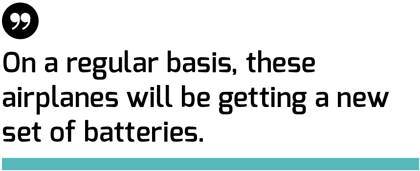
Wait a minute – why should the lifetime of a battery pack be shorter in an airplane than in a car? It isn’t. The cycle life is the same, but the calendar life is shorter because the battery is being used in a different way. Knapp explains: “A battery is sized at about 1,000 to 1,200 cycles of full charge and discharge. For a car, where a lot of their drives are really short, they’ll only see maybe 100 cycles a year, so 1,000 cycles in the 10-year lifetime of the car.”
Zunum’s hybrid aircraft, however, will fully deplete the battery on every flight. “Even a half-hour flight, you’re going to end up depleting the battery, so if you fly the airplane five or six times a day, you’ve gone five or six full cycles in a day. So, out of 1,000 cycles, that’s 200 days.”
At first glance, this may sound like a problem, but it’s actually an advantage. Remember, with a plane the important figure isn’t the cost of the vehicle, but the cost per passenger/mile. Using the batteries that are coming out of Tesla’s Gigafactory today (for example), this cost is already considerably lower than it is with a fossil-fuel aircraft. And as the battery packs are replaced, it will quickly get even lower. “As batteries continue to improve – and the trend has been a five or six percent improvement every year – the business case on the airplane gets better and better,” Knapp explains. “On a regular basis, these airplanes will be getting a new set of batteries, and the operator will be able to routinely get upgraded at the [newest] level of technology.”
Zunum’s airframe is designed to be battery-agnostic, so it will be able to take advantage of new developments in battery packs. “An airplane typically lasts 20 or 25 years, so we’ve got to forecast for batteries for the next 25 years,” says Knapp. “We are [assuming] that the storage technologies are going to continue to improve, and our airplanes are designed to be future-proof, so the operator continues to see improving range, speed, and cost.”
Considering that its duty cycle is so different from that of a car, does an airplane require a different battery chemistry or pack design? Not really, says Knapp. “Our requirements are similar to [that of an EV]. A small hybrid, like a Prius, has a very high-rate charge/discharge in a small battery – that is not the battery that we need. But the pack that would be in a Volt or a Tesla, a large-format, large-capacity, high-source-density pack, those are the sorts of batteries that we will use in the aircraft.”

Zunum plans to develop its own battery packs, but will source the battery modules from a vendor. Knapp mentioned Tesla, but said that the company has had discussions with various battery suppliers, and declined to be any more specific. “We’ll get the best of what’s being offered on the market. But, at the same time, we are an FAA-certified product, which means that we need to have control over what that pack looks like and how heavy it is, how it fits in the airplane, and show the FAA that we have a safe solution to hauling a lot of kilowatt-hours around the Earth.”
Planning for efficiency
Another difference between designing an electric car and an electric plane has to do with the fact that, when an airplane sets out on a journey, its operators typically know exactly how far it’s going to travel, and at what speed. This means that engineers can design a plane with just the right size battery for its intended use case (something like a bus, which can be designed with just enough range for a fixed route), whereas designers of a passenger car must plan for every conceivable trip that a consumer might want to make. It also enables an electric plane’s control software to optimize efficiency for a particular trip.
“The hybrid lets us tailor the airplane to fly a range/speed profile,” Knapp explains. “When you take off in an airplane, you usually know how far you’re going, how fast you’re going to fly, and how much energy you’re going to use, and you’ll have a forecast of the winds aloft. So part of our technology development is how to optimally utilize the various parts of the powertrain to deliver the most cost-effective, energy-efficient flight over that distance and speed.”
“The range/speed profile is the key. That’s not really a variable that you have access to when you drive, so you can’t optimize the cycle between the combustion and the battery, which is something that we spend a good bit of time and effort developing. It is quite a different proposition, really, flying versus driving.”

“The platform management software that we’re developing is designed to enable the pilot to have minimal extra workload to manage this new system, and it’s a fairly complex system,” says Knapp. “You’ve got a stored energy source and a generation energy source, which don’t function the same way with respect to altitude, with respect to discharge rate. So part of our development is to make sure that an existing traditional pilot will be able to fly these with minimal extra training, so that we can step right into the existing pool of pilots and operators and airports and air traffic control and have a viable commercial product right off the starting line.”
From the ground up
Zunum has designed a family of aircraft, guided by feedback from operators of on-demand and business aviation services, as well as at least one mainstream airline.
Zunum’s plane uses a new type of propulsion – it isn’t a jet, but it isn’t exactly a traditional propeller plane either. “We’re developing what we call a quiet electric propulsor, which is a ducted fan with an electric motor integrated in the duct. So it looks like a jet engine and it uses a lot of the same technology for the bypass fan of a conventional jet engine, but is a completely electrically driven fan.”
The new e-plane will be a plug-in series hybrid, designed as a modular system that could accommodate different types of combustion engines – a turbodiesel, a turbine burning jet A, or conceivably a fuel cell, if those prove to be a viable option.
“We are developing all our aircraft from the ground up as electric planes,” says Knapp. “We will use an existing aircraft as a test bed to get our technology in the air and flying more quickly, but the eventual product will be an all-new aircraft.”
Other than the drivetrain, does building an electric aircraft require major changes to the design? “It requires some,” says Knapp. “As [Slovenian light aircraft manufacturer] Pipistrel has shown with their two-seat trainer, you can have an airplane that looks almost the same, and they actually have the same airplane, one that has a gas engine and one that has an electric motor and a battery pack in the same space. So fundamentally, you can have that level of plug-and-play.” At the other end of the spectrum, several companies (including Workhorse, profiled in the May/June 2017 issue of Charged) are building vertical take-off aircraft that use multiple small electric motors.
“We’re somewhere in the middle. Our airplane looks more conventional, but the design criteria have changed a little bit. They’re carrying big liquid fuel, we’re carrying batteries. We have a generation engine we have to position somewhere, and properly provide that with fuel and cooling and all those things. So it doesn’t necessarily require big changes, but we do make some changes to optimize the aircraft for the most efficient integration and utilization of the electric engine.”
Zunum is currently working on ground-based prototypes, and plans to be flying an experimental test bed within the next two years. “We are targeting FAA certification in the early 2020s, and at launch, we’re looking at an aircraft that flies for 700 miles. As the decade progresses and the technology is improved, we will continue to improve the aircraft and be looking at flights up to 1,000 miles by 2030.”
What about charging?
“The charging infrastructure is much less of a dramatic shift than anything in the automotive world,” Knapp told us. “We’re talking about 5,000 airports compared to 11 million gas stations in the country. So to some extent it’s really not a huge problem.” Electric buses could provide a model – Zunum’s home metro area, Seattle, recently deployed several Proterra e-buses, and Knapp was impressed when he saw the company’s fully automated charging system in action. “These guys pull in and top up the bus at a half-megawatt charge rate in like ten minutes, and it’s really astounding.”
This article originally appeared in Charged Issue 32 – July/August 2017 – Subscribe now.













